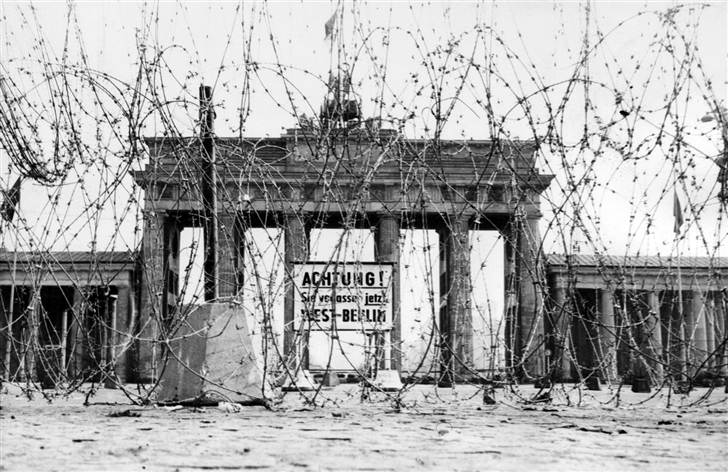50 years ago, the Berlin Wall arose to divide
http://www.msnbc.msn.com/id/44060292/ns/travel-news/
A city divided

The Berlin Wall was erected to separate East and West Berlin following the wider partition of Germany after the Second World War. Standing from 1961 to 1989, it became a symbol of the broader Cold War conflict. Half-controlled by Western forces, the city was geographically in the middle of the Soviet Occupation Zone of Germany and became a focal point for tensions between the NATO allies and the communist Eastern Bloc. In this image, the Brandenburg Gate is seen behind barbed wire in 1962. (John Waterman / Fox Photos via Getty Images)
Fifty years ago, the Soviet-controlled German Democratic Republic began to build what it euphemistically called its “Anti-Fascist Protection Rampart,” better known as the Berlin Wall.
Few then could have imagined that the concrete wall would become a blood-soaked symbol of the Cold War.
But on Aug. 13, 1961, engineers for the Communist-controlled dictatorship began erecting a barbed-wire fence around West Berlin in an attempt to demonstrate East Germany’s sovereignty to the world and prevent a population that disagreed with its policies from fleeing to the West.
Klaus-M. von Keussler was a 23-year-old university law student in West Berlin in 1961. He remembers thinking when the wall began going up that it would be temporary nuisance.
He couldn’t have known it would endure for 28 years and would transform his life from earnest law student to passionate freedom fighter who risked his life to help 68 defectors defeat a wall fortified with beds of nails, attack dogs, bunkers and 116 watchtowers manned by guards with orders to shoot to kill.
“None of us believed it would last more than a few weeks,” says von Keussler. “When we realized it wasn’t going away, we went into the escape-helping business. We saw it as our duty. We knew a free Berlin was a bone stuck in the throat of the Soviets and their desire for a unified Communist East Germany.”
Fragmented wall on display
The history of the wall has long been overshadowed by the events of Nov. 9, 1989, when crowds rushed the border after a new emigration law was falsely announced and the wall tumbled under the onslaught of people.
Today, more than 72 sections of the wall have been purchased or donated for display around the world in parks, presidential libraries, museums, church yards and in resort playgrounds, hotel lobbies and Las Vegas casinos where people gamble for stakes far less consequential than the ones that escaping East Germans faced.
European travel expert Rick Steves said Berlin today is so vibrant that guidebooks published just 10 years ago are today obsolete.
That dynamism has not gone unnoticed by world travelers, according to VisitBerlin CEO Burkhard Kieker, who said more than 8.1 million tourists visited the city in just the first five months of 2011.
“What’s really astounding is today people from 180 nations live peacefully together in a formerly divided city,” he says. “The wall affected the fate of many Berliners but they found a unique way to cope with it. You see wall memorials on the one hand and colorful painted wall remains on the other. And this mixture attracts even more visitors, especially on occasions like the 50th anniversary of the building of the wall.”
But the global euphoria surrounding the end of the wall, and the collapse of East Germany has for an entire generation obscured the inhuman blight of what the wall meant to men like retired Col. Vern Pike.
“The bitterness of what happened there will never leave me,” Pike says. “The Berlin Wall today is something people celebrate, but I have too many excruciating memories of it to ever celebrate it.”
More ceremonies will take place on the Contemporary History Information Mile where victims’ associations, border area museums and memorial sites will hold educational ceremonies.
Day of remembrance
Beginning at 1 a.m. on Aug. 13, a day of commemorations, prayers and artistic expression will take place at the Berlin Wall Foundation along the historic Bernauer Strasse. Ceremonies will include the readings of the names of 157 East Germans who were killed trying to escape between 1961 and 1989. Some estimates put the total gunned down at nearly twice that number.
Visitors will learn what Pike, today a 75-year-old military retiree living in Pinehurst, N.C., saw that infamous night when he was a 25-year-old military policeman on duty at what became famous to the world as Checkpoint Charlie, a flash point of Cold War tensions between East and West.
“It was 1 a.m. and I got a report something strange was going on,” Pike says. “East German engineers were digging post holes in the middle of the street and stringing barbed wire around their quadrant of the city.”
Uneasy peace treaties from World War II had divided Berlin into four distinct sectors with victorious allies (U.S., French, U.K. and the Soviets) each getting one piece of the 3.5 million-person metropolitan pie.
They eventually built the Berlin Wall under the guise that Berlin had not been purified of Nazi influence.